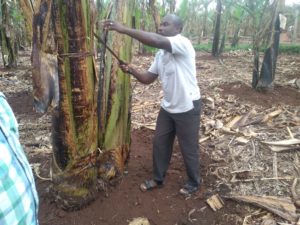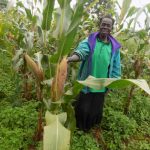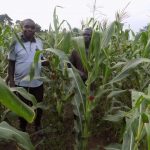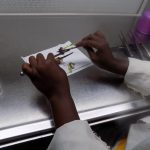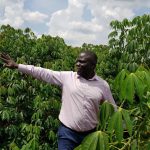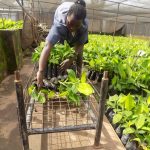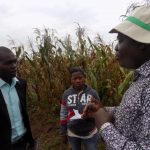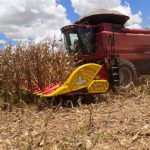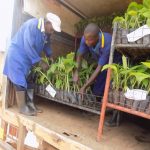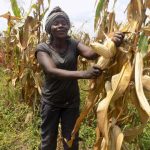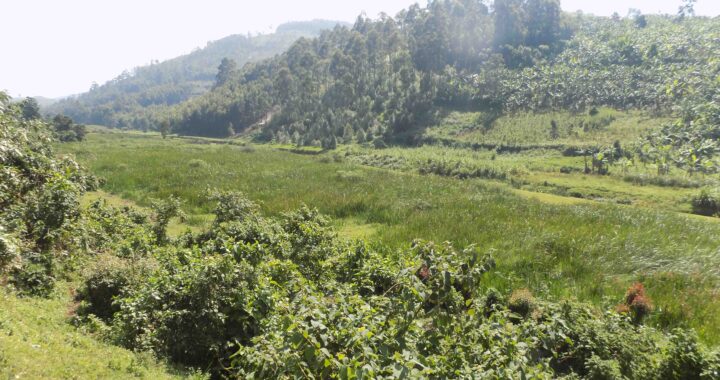Tissue culture seedlings take root in Uganda
3 min readTissue culture seedlings take root in Uganda
By Christopher Bendana
Ntungamo district
The corms and stems are huge, a sign of an incoming big bunch. The plant is also tall. This is banana land. The Ankole hinterland. The traditional agriculturalists grow it as well as the cattle keepers. Everyone here grows bananas, The East African Highland type called Matooke. The fruit is eaten as katogo (breakfast). Here, the fingers are either boiled with meat or beans. It is mashed then served with sauce like beef and eaten at dinner.
Farmers have practiced a traditional agricultural system passed over from generation to generation. To generate a new plant family, a farmer uproots a sucker from a family. This one is planted to create a new family.
But of recent, farmers have modernized and are planting suckers developed from cells in a process referred to as tissue culture.
Cells from a preferred variety are picked and placed on a media sub-division.
Tissue culture is the growing of plants in test tubes in a controlled environment. Here, cells from a preferred variety are picked and placed on a media which provides the necessary nutrients, just like it would be with soil.
Temperature and nutrients are controlled. With the technology, the plant breeder can produce fast and in bulk clean plantlets free of diseases. It is commonly used in vegetative crops like bananas, Irish potatoes, and coffee. Crops that don’t develop from seed.
Farmers are usually interested in high yielding, tolerant and resistant to insect pests and diseases, and fast-maturing varieties
For the case of banana, Erostus Nsubuga, founder and managing director at Agro-Genetic Technologies Laboratories (AGT), a company that specializes in tissue culture, says many farmers prefer the mpologoma variety which is fast maturing.
The farmer provides the lab with the meristem part of the banana, the inner part of the banana plant. Nsubuga says that each meristem can produce over 3,000 plantlets in seven months.
Barnabas Arinaitwe, a banana farmer in Rubaare, Ntungamo district is one such early adopter.
The National Agricultural Advisory Services (NAADS) gave him his self-tissue culture banana plantlets because he was a model farmer.
Since then he has fallen in love with tissue culture banana plantlets.
“I would even pay Shs 5000 for each plantlet,” he said.
When you visit his plantation, you have to like banana farming. Each family hosts three banana plants, a mother, daughter, and granddaughter. The stems are big as are the bunches.
“With tissue culture, I get big bunches. This is because they plant a clean plantlet free of pests and diseases,” he said.
However, Jerome Kubiriba, a banana breeder with the National Banana Program at the National Agricultural Research Laboratories, Kawanda puts a caveat on tissue culture plantlets.
“They are clean seeds, but they are not resistant to diseases,” he warns.
Bananas in Uganda are mainly affected by Banana Bacteria Wilt, Nematodes, and Black Sigatoka
One viable solution is to plant suckers that are free of diseases and limit the movement of planting materials.
A study by Lucy Mulugo of Makerere University and other, Sustainability 2020, Seed Security Factors Driving Framer Decisions on uptake of Tissue Culture Banana Seed in Central Uganda found a positive attitude toward tissue culture plantlets among farmers. This attitude is influenced by seed security factors.
Advantages of using tissue culture
They are disease free, and can be produced in bulk. Their transportation is also easy as they are small in size.
